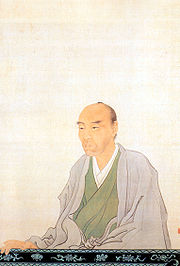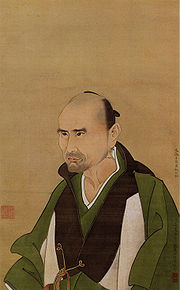
Watanabe Kazan
Encyclopedia

Japan
Japan is an island nation in East Asia. Located in the Pacific Ocean, it lies to the east of the Sea of Japan, China, North Korea, South Korea and Russia, stretching from the Sea of Okhotsk in the north to the East China Sea and Taiwan in the south...
ese painter
Painting
Painting is the practice of applying paint, pigment, color or other medium to a surface . The application of the medium is commonly applied to the base with a brush but other objects can be used. In art, the term painting describes both the act and the result of the action. However, painting is...
, scholar and statesman member of the samurai
Samurai
is the term for the military nobility of pre-industrial Japan. According to translator William Scott Wilson: "In Chinese, the character 侍 was originally a verb meaning to wait upon or accompany a person in the upper ranks of society, and this is also true of the original term in Japanese, saburau...
class.
Early life
He was born Watanabe Sadayasu in EdoEdo
, also romanized as Yedo or Yeddo, is the former name of the Japanese capital Tokyo, and was the seat of power for the Tokugawa shogunate which ruled Japan from 1603 to 1868...
(now Tokyo
Tokyo
, ; officially , is one of the 47 prefectures of Japan. Tokyo is the capital of Japan, the center of the Greater Tokyo Area, and the largest metropolitan area of Japan. It is the seat of the Japanese government and the Imperial Palace, and the home of the Japanese Imperial Family...
) to a poor samurai
Samurai
is the term for the military nobility of pre-industrial Japan. According to translator William Scott Wilson: "In Chinese, the character 侍 was originally a verb meaning to wait upon or accompany a person in the upper ranks of society, and this is also true of the original term in Japanese, saburau...
family, and his artistic talent was developed from an early age. His family served the lord
Daimyo
is a generic term referring to the powerful territorial lords in pre-modern Japan who ruled most of the country from their vast, hereditary land holdings...
of the Tahara Domain
Tahara Domain
was a minor fudai Japanese domain of the Edo period, located in southern Mikawa Province , Japan. It was centered on Tahara Castle in what is now the city of Tahara.-History:...
, located in present day Aichi prefecture. Watanabe himself served the lord of Tahara as a senior councilor
KARO
KARO is a radio station licensed to serve Nyssa, Oregon, USA. The station is owned by the Educational Media Foundation.It broadcasts a Contemporary Christian music format as part of the Air 1 network.-History:...
. He was heavily influenced by the artistic styles of the West
Western world
The Western world, also known as the West and the Occident , is a term referring to the countries of Western Europe , the countries of the Americas, as well all countries of Northern and Central Europe, Australia and New Zealand...
, forming a unique style with elements of Japanese and European art.
Work and politics

Daimyo
is a generic term referring to the powerful territorial lords in pre-modern Japan who ruled most of the country from their vast, hereditary land holdings...
, and on the other he was enthusiastic about Western ideas regarding science and politics. He wrote two private essays which were interpreted as being critical of the Shogunate's defense of Tokyo Bay
Tokyo Bay
is a bay in the southern Kantō region of Japan. Its old name was .-Geography:Tokyo Bay is surrounded by the Bōsō Peninsula to the east and the Miura Peninsula to the west. In a narrow sense, Tokyo Bay is the area north of the straight line formed by the on the Miura Peninsula on one end and on...
and promoting Western ideas. Although these papers were discarded by Watanabe, they were found and he was tried and exiled to his home province of Tahara. One of the conditions of his exile was that he wouldn't sell his paintings, however Watanabe continued selling his paintings in secret due to financial hardships. This was eventually discovered leading to the suppression of his works and house arrest
House arrest
In justice and law, house arrest is a measure by which a person is confined by the authorities to his or her residence. Travel is usually restricted, if allowed at all...
.
Death
Due to the political turmoil involved in this, Watanabe committed ritual suicide (seppukuSeppuku
is a form of Japanese ritual suicide by disembowelment. Seppuku was originally reserved only for samurai. Part of the samurai bushido honor code, seppuku was either used voluntarily by samurai to die with honor rather than fall into the hands of their enemies , or as a form of capital punishment...
) as a way to amend for the embarrassment he caused his lord.
Source
- Watanabe Kazan at Artcyclopedia.com

